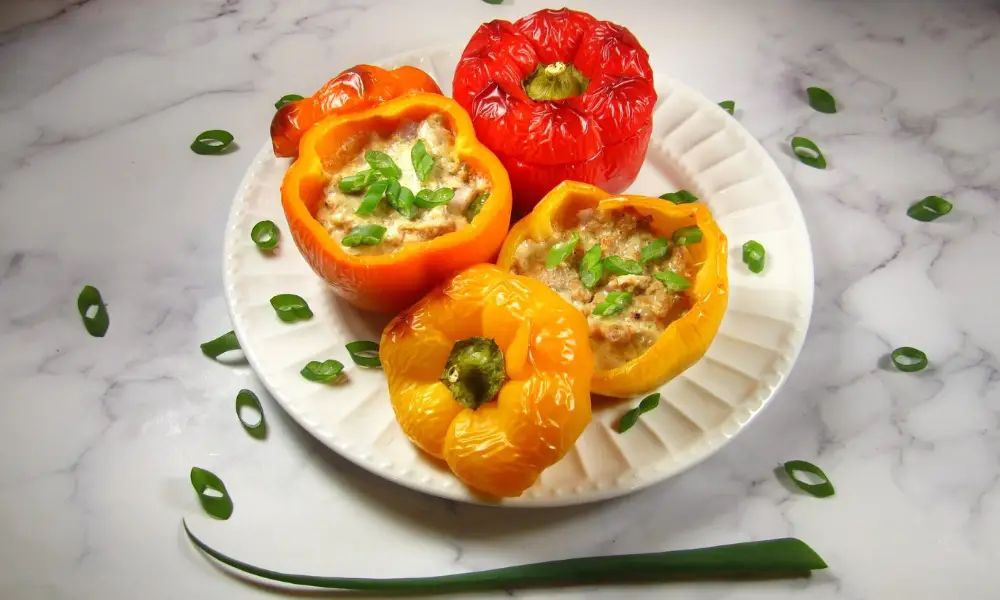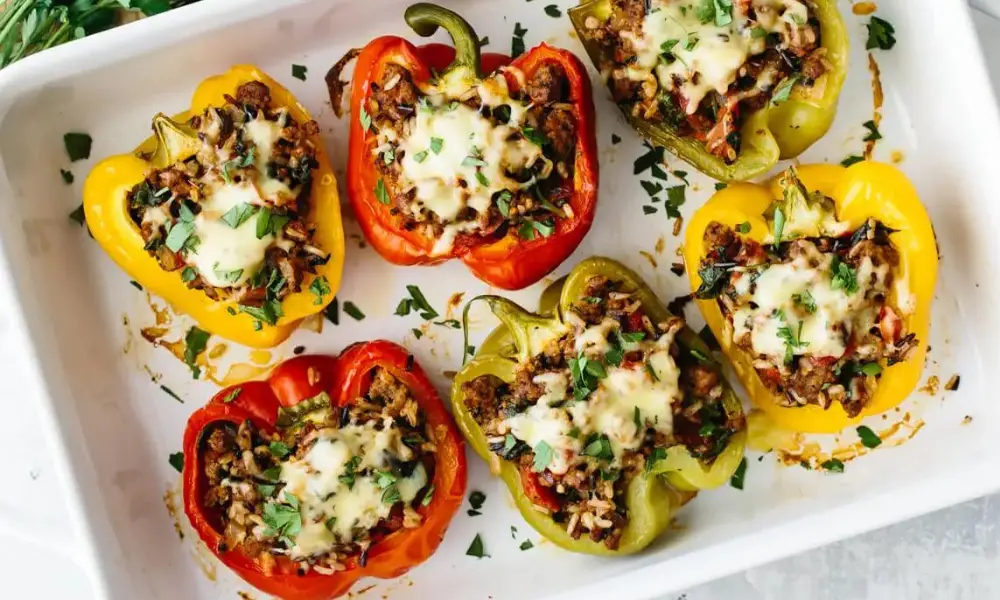Whether in a hurry or are pressed for time, stuffed peppers freeze well and taste great reheated. To prepare stuffed peppers for freezing, place them in a tightly-sealed container and cover them tightly with plastic wrap or aluminum foil. It would help to wrap the stuffed pepper tightly to avoid freezer burn. Alternatively, you can place them in a plastic resealable bag and seal the air.

What are Stuffed Peppers?
In many different cuisines, stuffed peppers are a typical dish. The meal comprises peppers hollowed out or cut in half and filled with various ingredients. For instance, they might be fruits, vegetables, meat, or whole grains like quinoa. The bell pepper may be orange, red, green, or yellow.
The green peppers are the most frequently used, which may help to explain why there are so many recipes for stuffed green peppers. The other bell peppers can nevertheless still be utilized. Slice your bell pepper and stuff the cavities with your chosen contents to make the stuffed peppers dish.
How to Freeze Stuffed Peppers?
Freezing Cooked Stuffed Peppers
- Make sure your peppers are adequately cooked before using this approach. Do not undercook foods, especially meats! Before freezing the filled peppers, make sure they have completely cooled.
- You may keep them in a baking dish or individually wrap them once they have cooled. Later, reheating them in the oven will go more quickly if you put them in a baking dish, but you may also warm one or two at a time by individually wrapping them.
- Place your stuffed peppers upright with sufficient room between them to store them all in one dish. Put plastic wrap over the entire baking dish next. It’s best to wrap everything, not just the dish’s top, and to use two layers.
- Once you’ve finished, cover the baking pan with a sheet of aluminum foil and tuck it in the sides. Your peppers will remain fresher for a more extended period because no moisture can enter.
- Wrap each cooked stuffed pepper snugly with plastic wrap to preserve them separately. Two layers are advised!
- Then, put each pepper wrapped into an airtight plastic bag that can be frozen. Before sealing, be sure to squeeze out any extra air.
Freezing Uncooked Stuffed Peppers
- Uncooked stuffed peppers can be frozen, but the stuffing must be prepared. According to your recipe, prepare all the stuffing components, then set them aside.
- To soften the peppers, blanch them for a short time in boiling water. You can begin adding the cooked stuffing ingredients once they have cooled.
- The same method is for cooking and prepping your uncooked stuffed peppers for the freezer. You can put them in a baking pan, cover them with foil, and wrap the pan in two pieces of plastic wrap. Ensure that the pan is completely sealed.
- You could also package each one separately. Simply double-wrap each stuffed pepper before putting them together in a Ziploc bag or other airtight container.
How to Thaw Stuffed Peppers from Freeze?
There are a few things to remember when you defrost those mouthwatering stuffed peppers when it’s finally time to eat them.
Bake frozen prepared stuffed peppers at 350 degrees Fahrenheit for 30 minutes, or until they are fully defrosted and comfortable. They can be defrosted in the refrigerator overnight if you prefer a shorter baking time.
The procedure is the same for frozen, raw peppers, but you’ll need to increase your baking time by 20 minutes.
How to Reheat Stuffed Pepper?
In the Oven
You can reheat your stuffed peppers in the oven because you likely cooked there too.
The peppers will produce excellent, pleasant results.
Be aware that reheating stuffed peppers in the oven is the most practical choice if you have many of them.
In the oven, reheat stuffed peppers as follows:
- Set your oven’s temperature to 350°F (180°C).
- Microwave the filled peppers for 20–30 seconds (optional step, recommended for more giant stuffed peppers).
- In an oven-safe dish, arrange the stuffed peppers, top with a tablespoon of water, and cover with foil (or a lid).
- The filled peppers should be baked for 15 to 20 minutes or until well heated. The time it takes for the peppers to thoroughly warm if the microwave step is omitted is up to 30 minutes.
- For the final five minutes of cooking, take off the foil to let the cheese crisp up.
Use a food thermometer to make sure the stuffed peppers are boiling. The inside temperature must exceed 165°F (74°C). Additionally, you can probe it with a knife to feel how hot it is as it comes out.
The center of the stuffed peppers will take the longest to heat up because the oven is slow. Before placing your stuffed peppers in the oven, they can benefit from 20 seconds in the microwave if they are on the larger side.
The stuffed pepper’s interior will be heated in the microwave, cutting down on time it needs to warm up in the oven.
Cutting the peppers in half before heating them can reduce the heating time.
Stuffed peppers from frozen can also be warmed up in the oven. Depending on the size of the pepper, it should take 40 to 45 minutes.
In the Air Fryer
The air fryer is a suitable middle ground between an oven and a microwave, and it cooks food quicker than an oven and has a little more taste than a microwave.
In the air fryer, reheat stuffed peppers as follows:
- Set the air fryer’s thermostat to 350°F (180°C).
- Before placing the filled peppers in the air fryer, microwave them for 20 to 30 seconds (optional but recommended for big stuffed peppers).
- Place the stuffed peppers in the air fryer basket, standing upright and apart from one another.
- The stuffed peppers should be heated thoroughly in the air fryer for around 10-15 minutes. The heating process will take closer to 15-20 minutes if the microwave stage is omitted.
Before serving, always check the stuffed pepper’s internal temperature since the outside may feel extremely hot, but the interior may still be lukewarm.
I use a food thermometer, but you can insert a knife and feel the temperature when you remove it. You want to check the thermometer for a reading of 165°F (74°C).
The center of stuffed peppers takes a while to heat up since they are so dense.
Because it provides the middle of the pepper a head start, the microwave stage reduces the time needed in the air fryer.
Even though it is not required, it is highly worthwhile if you have ample, meaty-filled peppers.
Your frozen stuffed peppers can also be warmed up in the air fryer and extend the heating process by 10–12 minutes.
Stuffed Peppers: Are They Healthy?
There are many disagreements over how healthy and beneficial this cuisine is. Without a doubt, it is healthful. As a result of its preparation with nutritional components, including bell peppers, quinoa, and vegetables, this dish is considered healthy and suitable for eating by reliable specialists.
Again, due to the bell pepper’s many health advantages, food experts consider this dish to be healthful.
Some of the health advantages of eating bell peppers are listed below:
Higher Vitamin C
Red bell peppers, in particular, provide a lot of vitamin C. 95 milligrams of vitamin C are present in half a cup of raw red pepper, according to Medical News Today. This amounts to 106% of the Daily Value (DV) for adults and kids over the age of four.
Because it supports several bodily processes, vitamin C is essential. For instance, it supports the immune system and aids collagen formation, protein metabolism, improved nonheme iron absorption, etc.
High Levels of Vitamin A
Vitamin A is abundant in bell peppers as well. About 117 micrograms of retinol activity equivalents, or 13% of the suggested DV, are present in half a cup of raw red pepper. Red peppers contain beta carotene, a type of vitamin A that the body transforms into an active form.
Again, vitamin A is essential for many functions in our bodies. Reproduction, eyesight, immunological function, cell proliferation, and healthy organ function are just a few.
Antioxidant
Antioxidants such as flavonoids, quercetin, beta carotene, lycopene, capsaicinoids, and luteolin are also abundant in bell peppers. Since they play various roles in the body, all of these antioxidants are crucial. Some of these include protection of the brain cells, decreased risk of conditions like diabetes and cataracts, and prevention of oxidative cell damage.
Reduced Risk of Disease
Bell peppers have also effectively lowered the risk of inflammatory disorders like arthritis. This is due to its abundance in beta-cryptoxanthin, and vitamin C, claims Medical News Today. The carotenoid beta-cryptoxanthin, which is present in orange and red peppers, lowers the chance of developing rheumatoid arthritis.
Nutritional Value
Bell peppers are a rich source of vitamins, minerals, and other substances your body needs to function correctly. Some are potassium, fiber, folic acid, and vitamins A and C.
Reduced Calorie
Bell peppers are a mainstay in most meal plans for weight loss because they are deficient in calories. Additionally, they contain a lot of fiber, which supports digestive health and heightens feelings of satiety, reducing hunger.
How to Cook Stuffed Peppers?
Ingredients:
- Uncooked rice, 1/2 cup
- Extra virgin olive oil, two tablespoons plus more for drizzling
- One chopped medium onion
- a half-cup of tomato paste
- Three minced garlic cloves
- 1 pound of ground beef
- 1 (14.5-oz) tomato dice can
- 1.5 teaspoons dried oregano
- salt
- black pepper freshly ground
- Six bell peppers, stripped from the tops and cores
- Monterey jack, shredded, one cup
- parsley, freshly chopped, as a garnish
Directions:
- 400° oven preheat. Rice should be cooked in a small pot according to the directions on the package. Heat oil in a big skillet over medium heat. Five minutes should be enough time to soften the onion. Add the tomato paste and garlic and stir until fragrant for approximately a minute. Add the ground beef and cook for 6 minutes, breaking up the meat with a wooden spoon, or until it is no longer pink. Remove fat.
- Stir in the cooked rice and diced tomatoes before adding the beef mixture to the skillet. Add oregano, salt, and pepper for seasoning. Allow to simmer for 5 minutes or until liquid has somewhat reduced.
- In a 9″ x 13″ baking dish, arrange the peppers cut side up and drizzle with oil. Fill each pepper with the beef mixture, sprinkle Monterey jack cheese on top, and then cover the baking dish with foil.
- About 35 minutes into baking, the peppers should be soft. Ten more minutes of baking are required after removing the cover.
- Add parsley as a garnish before serving.
Conclusion
If you freeze stuffed peppers, the best way to cook them later is to thaw them overnight in the fridge. Alternatively, you can place frozen peppers in the oven at 350 degrees for about 10 to 12 minutes. If you are pressed for time, thaw the stuffed peppers in the refrigerator overnight. To reheat frozen stuffed peppers, thaw them in the fridge overnight and then bake them for about 15 to 20 minutes. You can also store leftover peppers in the refrigerator for up to two days, but eating them within two or three days is recommended.

